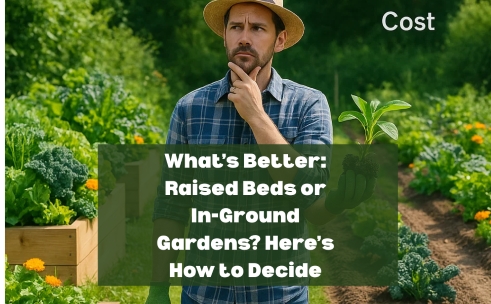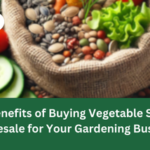Ready to grow your food or flowers… but not sure if you should dig a hole or build a box? Let’s settle this once and for all.
You’re not the only person who has been looking through garden inspiration and questioning whether in-ground planting or raised beds are a better option. One appears clean and contemporary, while the other has an earthy, vintage vibe.
However, both have genuine benefits (and some disadvantages) that go beyond appearances. This tutorial takes you step-by-step through the decision-making process so you can spend more time improving and less time second-guessing.
Understanding the Basics of Raised Beds and In-Ground Gardens
What Are Raised Beds?
Garden boxes elevated above the ground are called raised beds. Typically, they are made of composite, metal, or wood. By containing soil and plants, these buildings provide a controlled growing environment.
Small 3×3-foot beds and larger 4×8-foot configurations are examples of common sizes. They may be tailored to your needs and available area, making gardening more accessible and simple.
What Are In-Ground Gardens?
Plants are traditionally grown in in-ground gardens. They make use of the dirt that is already there in your yard or field. Gardeners create vegetable plots, flower beds, and landscape borders by planting straight into the ground.
This approach frequently requires minimal setup and depends on the natural terrain. Although many home gardens have seen it before, soil conditions must be taken into consideration.
Differences: Raised Beds Or In-Ground Gardens
| Feature | Raised Beds | In-Ground Gardens |
| Cost | Higher (materials and soil) | Lower (mostly free, depends on soil) |
| Setup Time | Moderate (building and filling beds) | Minimal |
| Soil Quality Control | Excellent (custom mix) | Varies, depending on the native soil |
| Accessibility | Easier for bending and reaching | Can be hard on knees or back |
| Drainage | Better, reduces waterlogging | Varies, may need drainage solutions |
| Expansion | Limited by space or design | Easier to expand naturally |
Advantages of Raised Beds
Soil Quality Control and Improved Drainage
Controlling the soil you plant in is one of the main benefits of raised beds. They can be filled with a mixture of peat, compost, and high-quality garden soil.
This gives plants the nutrition they require to flourish robustly. Additionally, raised beds drain more effectively, preventing waterlogging of the roots and minimising root rot and other problems.
Pest and Weed Management
It’s easier to keep weeds and pests out of raised beds. Covers or obstacles can be placed on top.
Additionally, weeds are simpler to identify and eradicate because the soil is enclosed. Certain pests, such as snails and insects that live on the ground, are deterred by the structure.
Accessibility and Ergonomics
Raised beds are a lifeline for people who have problems kneeling or bending. By building them at a comfortable height, you can lessen the strain gardening puts on your joints and back. They are excellent for elderly people or anyone with limited mobility.
Extended Growing Season
Raised beds keep warmer into the fall and warm up more quickly in the spring. Your growing season may be extended as a result.
Early in the growing season, many gardeners find that planting in warm, well-drained soil increases yields.
Real-World Example
Raised beds are frequently used in urban community gardens to maximise space and guarantee accessibility.
This arrangement makes it possible for people of all ages and skill levels to enjoy gardening and yield a healthy crop.
Advantages of In-Ground Gardens
Cost-Effectiveness
Because you don’t need to purchase supplies like wood or soil supplements, starting an in-ground garden is less expensive up front.
It’s easier for larger plots or backyard landscapes because you just use the land you already have.
Integration with Natural Landscape
Plants that grow directly in the ground can take advantage of the local bacteria and soil. This allows native plants and perennials to flourish and fit in with their surroundings.
Space Utilization
Just clear a spot and begin planting; no construction is required. All it takes to grow your garden is to turn the soil over and add more plants.
This approach works best in rural areas and on large properties.
Maintenance and Longevity
Over time, in-ground gardens typically require less structural maintenance. With the right maintenance, your garden can endure for many years as the soil naturally replenishes itself and organisms become healthier.
Expert Insight
Farmers and soil scientists recognise the advantages of working with the natural earth. More robust gardens may result from its promotion of biodiversity, wholesome soil ecosystems, and simpler natural nutrient cycling.
Limitations and Challenges
Raised Beds
Raised beds are practical, but they can be expensive at first, particularly if you choose high-quality materials.
Additionally, they tend to dry out more quickly; thus, in order to keep plants happy, constant mulching and watering are required.
In-Ground Gardens
A common problem is poor native soil. Growing healthy plants becomes challenging if your soil is polluted, compacted, or poorly drained.
It may be necessary to add compost to the soil or think about using raised beds instead.
Both Methods
One factor is space. Site preparation becomes crucial because possibilities may be limited by small lots.
The optimal approach may also depend on the local climate, particularly in regions that experience drought or high rainfall.
How to Decide: Factors to Consider
Budget and Cost
Are you prepared to make the financial commitment to construct and stock raised beds? Or would you rather begin using your current land in a more economical manner?
Take into account both the initial setup and continuing expenses for things like watering or soil amendments.
Space and Location
Raised beds work well in small urban patios or yards, whereas conventional gardens thrive in bigger rural plots. Consider the amount of space you have available.
Soil Conditions and Quality
Before you plant, test your soil. Raised beds with decent soil may be the greatest choice if it is contaminated or poor. In-ground planting is more feasible when the local soil is healthy.
Gardening Goals
Do you want perennial plants, flowers, or vegetables? Which would you prefer, beautiful scenery or convenient access? Your decision will be influenced by your objectives.
Maintenance and Longevity
Take into account your level of physical fitness and the amount of time you wish to devote to gardening.
Although they sometimes need more work up front, raised beds can save labour costs over time. Regular soil treatment is necessary for in-ground gardens.
Climate and Environmental Factors
Plant health is impacted by weather conditions, including droughts and strong rainfall.
Traditional gardening may work well in some areas, but raised beds that hold moisture better may be more advantageous in others.
Actionable Tips for Making the Right Choice
- Test your soil’s health and drainage first.
- Add up the total investment in materials, soil, and tools.
- Start small: build a raised bed or an in-ground garden.
- Seek advice from local gardening centres or extension services.
- Consider a hybrid approach—use raised beds for veggies but keep perennials in the ground.
Conclusion
The decision between raised beds or in-ground is based on your gardening goals, available area, money, and personal demands.
Control, accessibility, and an extended growing season are all benefits of raised beds. However, in-ground gardens are less expensive and perform better when planted in native soil.
Examine your resources, objectives, and land thoroughly. Each approach has advantages and disadvantages. Plan for growth and start with what works best for you.
Enjoying your time outside and seeing your garden grow is what matters most. Have fun gardening!




